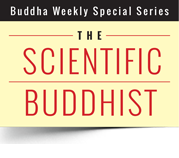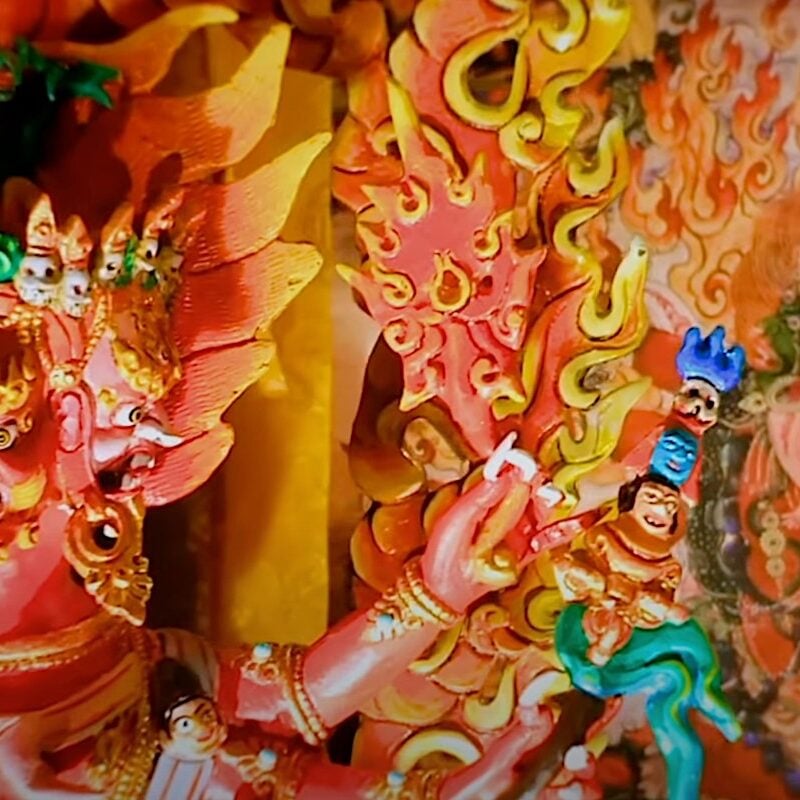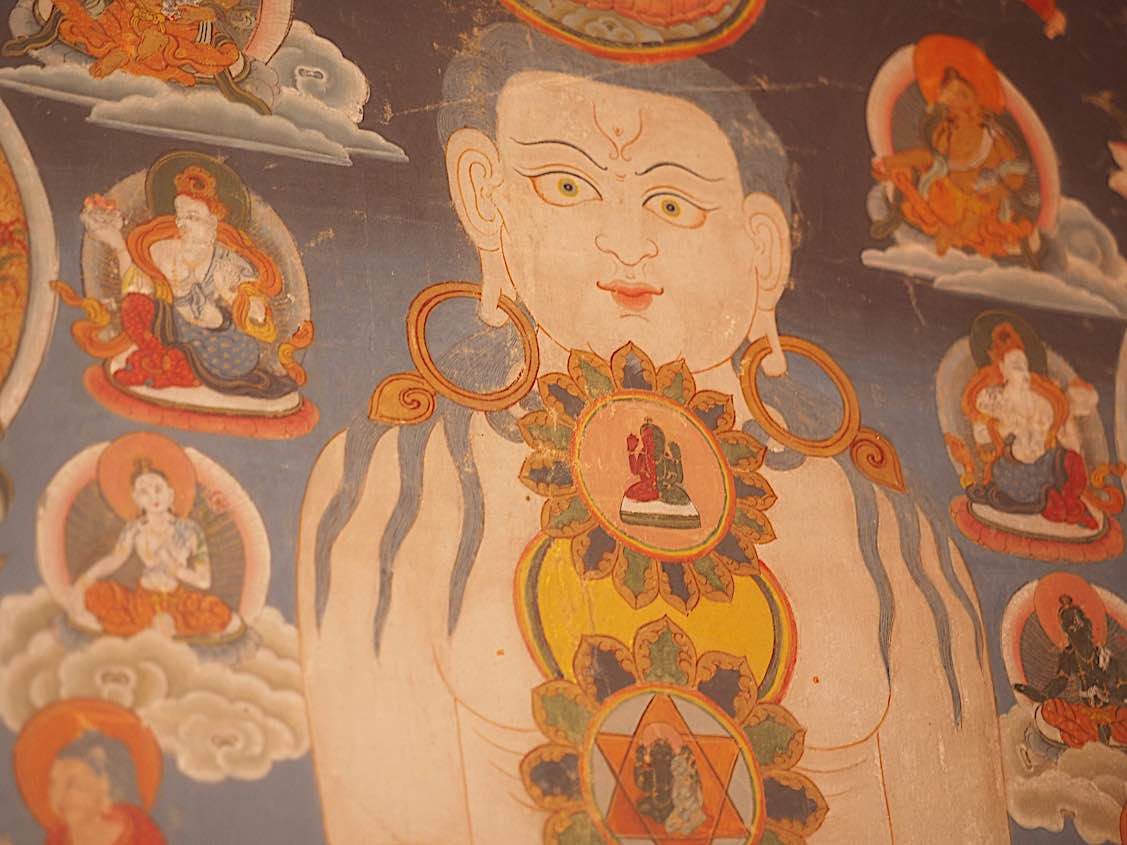Scientific Buddhist: Peer Reviewed Studies — Buddhist Metta Loving Kindness Meditation Can Slow Aging —10 Benefits of Compassion
In two recent Buddha Weekly advice videos, teacher Zasep Tulku Rinpoche explained that mindfulness meditation and loving-kindness meditations were among the best therapies for bereavement, stress, cognitive issues, memory loss, and even Alzheimer’s. (Bereavement Video>> and Cognitive Video>>)
Perhaps not surprisingly, peer-reviewed medical studies may corroborate this claim made by Buddhists for centuries. Here, we’ve pulled together ten key benefits and ten reviewed studies of those benefits of Loving Kindness Meditation (LKM).
Mindfulness meditation’s place as a genuine therapy with tangible health benefits is well documented and accepted by medical and psychiatric practitioners. (For our previous article on the peer-reviewed ten benefits of mindfulness, refer here>>)

Metta practice (maitrī in Sanskrit, metta in Pali) is common to all three major schools of Buddhism and has always been a pivotal practice in Buddhism. The daily Buddhist custom of the “Four Immeasurables” is part of this practice. (See end of this feature for this practice). These four states are qualities cultivated in Buddhist practice. In Mahayana Buddhism, Metta rises in significance even further, labeled more often as “Compassion” — which together with Wisdom are the path to Enlightenment. (Technically, Compassion is “karuna” rather than “metta”, although the distinction is small — see below for details.)
(LKV mediation steps and Metta Sutta chanting practice at end of this feature.)
10 Proven Benefits of Kindness and Compassion Meditation

Some of the benefits identified by medical or scientific research are (cited below):
- Reduction of stress, including increases in Respiratory Sinus Arrythmia (RSA)
- Slows aging (increases telormere length) (see inset)
- Increases brain matter
- Decreased illness
- Reduces chronic pain
- Decreases Post Traumatic Stress Disorder: PTSD
- Reduces incidence of migraines
- Decreases schizophrenia spectrum disorders (pilot study)
- Increases empathy, compassion, reduces bias and discrimination (no surprise there) and increases social connection
- Increases self worth and self love, reduces self-criticism — all of which can have positive impact on psychological and physical well-being.
A professor with a special focus on the science of happiness, Emma Seppala, summarizes the benefits this way: ” Research shows that Loving Kindness Meditation has a tremendous amount of benefits ranging from benefitting well-being, to giving relief from illness and improving emotional intelligence.” [4]
Regardless of your take — and future research findings — there can be no doubt that Loving Kindness Meditation (LKM) is every bit as beneficial as Buddha taught.
INSET: A t test showed that the expert meditators group (mean = 10.82 kb; SEM = 0.23; SD = 1.03) had a significantly longer MTL (t = 2.97; df = 38; p = 0.005; Cohen’s d = 0.94) compared with the comparison group (mean = 9.94 kb; SEM = 0.19; SD = 0.84). [Reference link>>]
The data concerning the 20th percentile were similar, showing that the prevalence of short telomeres in the cells of the expert meditators group (mean = 5.22 kb; SEM = 0.11; SD = 0.48) was significantly lower (t = 2.84; df = 38; p = 0.007; Cohen’s d = 0.91) than the comparison group (mean = 4.80 kb; SEM = 0.10; SD = 0.44).
A Mother’s Love and a Sense of Self Love

Interestingly, meditating on the love of others always increases a sense of “self love” and “self worth.” However, the focus of “Metta” meditation is a lofty one, as established by the Buddha, here explained in a Discourse by U Nandiya: “In the “Metta Sutta” the Buddha has chosen the love of a mother for her child as an example. Imagine a mother’s love when her child is hungry; she watches carefully to feed her child even before it asks her for food. When the child is in danger, she will risk her own life. So the Buddha taught us to love all beings as a mother loves her only child.” [2] In Metta meditation we have to expand this high level of love to include all sentient beings, not just people we like, but also our “enemies” and not just humans, but even the most scary creepy crawlies — all sentient beings.
Here are the top ten benefits (there are more), with some recent research to back them:
#1: Reduction of Stress: 2011 Study on Loving Kindness as a Buffer to Social Stress
From Abstract: “Loving-kindness meditation (LKM) has the potential to improve intrapersonal and interpersonal functioning. This unique quality of LKM makes it a desirable candidate for buffering the stress of being social evaluated or socially excluded. Using the Trier Social Stress Test and the Cyberball social exclusion paradigm, the present study investigated the effectiveness of a brief LKM session in buffering against social evaluative and social exclusion stress.” Details of study here>>
#2 Slow Aging: Longer Telomeres from Loving Kindness
From Abstract findings: ” The LKM [Loving Kindness Meditation] practitioners had longer RTL than controls at the trend level (p=.083); among women, the LKM practitioners had significantly longer RTL than controls, (p=.007), which remained significant even after controlling for BMI and past depression. Although limited by small sample size, these results offer the intriguing possibility that LKM practice, especially in women, might alter RTL, a biomarker associated with longevity.” Details of research here>>
Traditional style Pali chanting of the Metta Sutta (Sutta in full is at end of this feature):
#3 Increases Brain Matter: Promising for Cognitive Issues?

Sharon Salzberg, author of Loving Kindness.
From study 1: “Previous voxel-based morphometry (VBM) studies have revealed that meditation is associated with structural brain changes in regions underlying cognitive processes that are required for attention or mindfulness during meditation. This VBM study examined brain changes related to the practice of an emotion-oriented meditation: loving-kindness meditation (LKM). A 3 T magnetic resonance imaging (MRI) scanner captured images of the brain structures of 25 men, 10 of whom had practiced LKM in the Theravada tradition for at least 5 years. Compared with novices, more gray matter volume was detected in the right angular and posterior parahippocampal gyri in LKM experts. The right angular gyrus has not been previously reported to have structural differences associated with meditation, and its specific role in mind and cognitive empathy theory suggests the uniqueness of this finding for LKM practice. These regions are important for affective regulation associated with empathic response, anxiety and mood. At the same time, gray matter volume in the left temporal lobe in the LKM experts appeared to be greater, an observation that has also been reported in previous MRI meditation studies on meditation styles other than LKM. Overall, the findings of our study suggest that experience in LKM may influence brain structures associated with affective regulation.” Read more here>>
From study 2: “The comparison between meditation vs. rest states between experts and novices also showed increased activation in amygdala, right temporo-parietal junction (TPJ), and right posterior superior temporal sulcus (pSTS) in response to all sounds, suggesting, greater detection of the emotional sounds, and enhanced mentation in response to emotional human vocalizations for experts than novices during meditation. Together these data indicate that the mental expertise to cultivate positive emotion alters the activation of circuitries previously linked to empathy and theory of mind in response to emotional stimuli.” Read more>>
From study 3: “This study examined the dissociable neural effects of ānāpānasati (focused-attention meditation, FAM) and mettā (loving-kindness meditation, LKM) on BOLD signals during cognitive (continuous performance test, CPT) and affective (emotion-processing task, EPT, in which participants viewed affective pictures) processing. Twenty-two male Chinese expert meditators (11 FAM experts, 11 LKM experts) and 22 male Chinese novice meditators (11 FAM novices, 11 LKM novices) had their brain activity monitored by a 3T MRI scanner while performing the cognitive and affective tasks in both meditation and baseline states.” Read more>>
#4 Decreases Illnesses: Open Hearts Build Your Health and Wellness Resources

From study abstract: “The authors tested this build hypothesis in a field experiment with working adults (n = 139), half of whom were randomly-assigned to begin a practice of loving-kindness meditation. Results showed that this meditation practice produced increases over time in daily experiences of positive emotions, which, in turn, produced increases in a wide range of personal resources (e.g., increased mindfulness, purpose in life, social support, decreased illness symptoms). In turn, these increments in personal resources predicted increased life satisfaction and reduced depressive symptoms.” Read more>>
#5 Reduces Chronic Pain, Especially Low Back Pain
From study abstract: “Loving-kindness meditation has been used for centuries in the Buddhist tradition to develop love and transform anger into compassion. This pilot study tested an 8-week loving-kindness program for chronic low back pain patients…. Preliminary results suggest that the loving-kindness program can be beneficial in reducing pain, anger, and psychological distress in patients with persistent low back pain… Clinicians may find loving-kindness meditation helpful in the treatment of patients with persistent pain.” Read more>>
#6 Decreases Post Traumatic Stress Disorder: PTSD
From study abstract: “A large effect size was found for PTSD symptoms at 3-month follow-up (d = -0.89), and a medium effect size was found for depression at 3-month follow-up (d = -0.49). There was evidence of mediation of reductions in PTSD symptoms and depression by enhanced self-compassion. Overall, loving-kindness meditation appeared safe and acceptable and was associated with reduced symptoms of PTSD and depression.” Read more>>

#7 Reduced Incidence of Migraines
From study abstract: ” Meditation is gaining popularity as an effective means of managing and attenuating pain and has been particularly effective for migraines. Meditation additionally addresses the negative emotional states known to exist with migraines. The purpose of this study was to evaluate the effectiveness of meditation as an immediate intervention for reducing migraine pain as well as alleviating emotional tension, examined herein as a negative affect hypothesized to be correlated with pain. Twenty-seven migraineurs, with two to ten migraines per month, reported migraine-related pain and emotional tension ratings on a Likert scale (ranging from 0 to 10) before and after exposure to a brief meditation-based treatment. All participants were meditation- naïve, and attended one 20-minute guided meditation session based on the Buddhist “loving kindness” approach. After the session, participants reported a 33% decrease in pain and a 43% decrease in emotional tension. The data suggest that a single exposure to a brief meditative technique can significantly reduce pain and tension, as well as offer several clinical implications. It can be concluded that single exposure to a meditative technique can significantly reduce pain and tension. The effectiveness and immediacy of this intervention offers several implications for nurses.” Read more>>

#8 Decreases schizophrenia spectrum disorders
Pilot Study abstract: “This pilot study examined loving-kindness meditation (LKM) with 18 participants with schizophrenia-spectrum disorders and significant negative symptoms. Findings indicate that the intervention was feasible and associated with decreased negative symptoms and increased positive emotions and psychological recovery.” Read more>>
And Many More: Increases Compassion, Kindness, Social Connection and Reduces Bias
For benefits 9 and 10, most people would accept these results without reference to research or studies. Meditating on Loving Kindness intuitively would — logically — have benefits in these areas. There are, however, numerous controlled studies that verify this, too many to list here. Here are three helpful links:
How to Meditate on Loving Kindness
There are many suggestions from many teachers, but no greater teacher than Shakyamuni Buddha himself. Chanting the Metta Sutta (below) is certainly very effective, especially when combining with visualizing.

There are four kinds of loving kindness:
- Metta, or friendliness
- Karuna, or compassion
- Mudita, or appreciative joy
- Upekkha, or equanimity.
The principles of LKM:
- kindness
- patience
- trust
- non-striving
- a beginners mind
- no judging
- letting go
- acceptance
- staying in the moment (mindfulness).
One simple practice embraced by Buddhists around the world is a daily chanting or reciting of the Metta Sutta. The entire Metta Sutta in English and Pali are at the end of this feature. We’ve embedded two videos of Metta Sutta chanting, one traditional and one more “modern.” While chanting focus on loving all beings.

The Four Immeasurables
Most Buddhist practitioners include, in their daily practice, the “Four Immeasurables”, often phrased as:
May all sentient beings have happiness and the causes of happiness;
May all sentient beings be free from suffering and the causes of suffering;
May all sentient beings never be separated from the happiness that knows no suffering;
May all sentient beings live in equanimity, free from attachment and aversion.
In original Tibetan:
SEM CHEN TAM CHAY DE WA DANG DE WAY GYU DANG DEN PAR GYUR CHIG
SEM CHEN TAM CHAY DUG NGEL DANG DUG NGEL KYI GYU DANG DEL WAR GYUR CHIG
SEM CHEN TAM CHAY DUG NGEL ME PAY DE WA DANG MI DREL WAR GYUR CHIG
SEM CHEN TAM CHAY NYE RING CHAG DANG NYI DANG DREL WAY DANG NYOM LA NAY PAR GYUR CHIG
Self Love Important
Most teachers of Metta begin with a meditation on self love. Loving acceptance of the self is key to loving others. A person who loathes self cannot easily generate love for others.
The next step is to generate loving kindness to others. Here, a meditation (guided or otherwise) would be structured somewhat on the self and the “four types of persons” toward whom you should develop loving kindness. In this order, they are easier to accept, since the last one (a hostile person) is often the most difficult to visualize):
- self: start with the self
- beloved and highly respected person (such as your Guru)
- dear ones: family members and close friends
- neutral feelings: people you know but have no special positive of negative feelings about
- a hostile person: someone you dislike or are having troubles with.
Mechanics of LKV

There are three types of Metta meditations most commonly recommended: visualization, listing (reflection) and auditory.
Auditory is the simplest — and used by most Buddhist worldwide. This could include chanting the Four Immeasurables (above) or the Metta Sutta in either English or Pali (below). Aspirations, such as “May you be happy” are important. This particular practice could evolve into a social ritual outside of practice, where you might surprise your hostile associates with “be happy” wishes coming in to every day communication.
Perhaps more involved is “reflection” where you mentally list or affirm the positive aspects of one person from each of the groups. You imagine a respected, beloved, neutral, and hostile person and mentally acknowledge at least one positive thing about them.
Visualization is more formal, usually a part of advanced Buddhist practices, where they might be guided. Truly advanced visualizations include Vajrayana Buddhist meditations where you place all of your enemies in front of you and your friends/family behind you. This is to place emphasis on generating loving kindness towards the “enemies.” In Vajrayana practice you might visualize them as becoming Enlightened beings.
Below is a simple and effective meditation that includes all three.
A Simple 7-Step Meditation
Here’s a simple meditation for Buddhists and Non-Buddhists (for Non Buddhists omit step 3):
1.Sit yourself comfortably, in the same way as you would for mindfulness. You can also stand, recline or walk while meditating as long as you are able to focus (please don’t drive and meditate!)
2. Close your eyes and breathe. If you’re an experience meditator, practice a few moments of “mindfulness of breath.” Otherwise, simply be aware of the breath until totally relaxed.
3. For Buddhists, particularly Mahayanists, a focal point for loving kindness and compassion is Chenrezig or Avalokiteshvara (Guanin or Kwanyin/Kannon), the Buddha of Compassion. Any Buddha represents compassion, although Chenrezig is defined by it. It can be helpful to chant any Buddhist mantra for a few minutes, while visualizing the compassionate Buddha — especially the compassion mantra:
Om Mani Padme Hum

4. Traditional Tibetan Buddhist meditation focuses on visualizing all beings (as clearly as you can) sitting around us. Usually, we place our enemies in front, to remind us to treasure them, then strangers, then friends and family behind us. This is symbolic of reinforcing that even people hostile towards you need your love.
If this is too difficult, just visualize one person at a time. Again, try to start with a hostile person (It is helpful to pacify your own hostilities in this way). Then, simply “know” all sentient beings are around you and meditate on loving kindness for all of them. All sentient beings includes animals, insects and even those creatures you fear.
If it helps you focus, rather than visualizing in silence you could find it helpful here to either chant the Four Immeasurables over and over (This affirmation does not require you to be a Buddhist, and can be easily memorized):
May all sentient beings have happiness and the causes of happiness;
May all sentient beings be free from suffering and the causes of suffering;
May all sentient beings never be separated from the happiness that knows no suffering;
May all sentient beings live in equanimity, free from attachment and aversion.
5. If there is a person or being you are specifically having trouble with, a hostile person, or someone (or creature) who makes you afraid (such as spiders or snakes) focus specifically on that one being (or class of beings) and try to transform the image you see from a negative one (angry scowling face, for example) to a positive one (smiling or happy). Or see them dissolve into white pure loving light. In particular Buddhist practices we might see them transform into Buddhas (since all beings have Buddha Nature). Here, if you’d like to chant you could modify the four immeasurables to focus on that one being:
May you be happy, may you be free of suffering, may you be happy, may you be free of suffering… over and over.
6. When you come to a point where you feel only loving kindness for all beings, sit in the moment and feel the bliss of happiness.
7. Dedicate the merit. Although it’s a Buddhist practice, dedicating your merits can be seen as pure Loving Kindness affirmation. Finish your session with something like: “I dedicate my merits to happiness of all beings.” A Mahayana Buddhist would affirm something like: “I dedicate my merits to the cause for Enlightenment for the benefit of all Beings.”
Mindfulness and Loving Kindness Have No Downsides
Aside from a few minutes in time each day, both mindfulness and loving kindness meditation have at least ten solid benefits to health and mind well-being — each. For our list of peer reviewed research on the benefits of mindfulness, see here>>
For Buddhists, try a daily chant of the Metta Sutta (below.)
Beautiful sung Metta Sutta, chanted in Pali:
The Kindness Sutra
The Karaniya Metta Sutta translated by English Sangha Trust [1] (Pali transliteration for “chanting” is below):

This is what should be done
By one who is skilled in goodness,
And who knows the path of peace:
Let them be able and upright,
Straightforward and gentle in speech,
Humble and not conceited,
Contented and easily satisfied,
Unburdened with duties and frugal in their ways.
Peaceful and calm and wise and skillful,
Not proud or demanding in nature.
Let them not do the slightest thing
That the wise would later reprove.
Wishing: In gladness and in safety,
May all beings be at ease.
Whatever living beings there may be;
Whether they are weak or strong, omitting none,
The great or the mighty, medium, short or small,
The seen and the unseen,
Those living near and far away,
Those born and to-be-born —
May all beings be at ease!
Let none deceive another,
Or despise any being in any state.
Let none through anger or ill-will
Wish harm upon another.
Even as a mother protects with her life
Her child, her only child,
So with a boundless heart
Should one cherish all living beings;
Radiating kindness over the entire world:
Spreading upwards to the skies,
And downwards to the depths;
Outwards and unbounded,
Freed from hatred and ill-will.
Whether standing or walking, seated or lying down
Free from drowsiness,
One should sustain this recollection.
This is said to be the sublime abiding.
By not holding to fixed views,
The pure-hearted one, having clarity of vision,
Being freed from all sense desires,
Is not born again into this world.
In Pali (often used for daily chanting):
Karanīyam atthakusalena
yan taṃ santaṃ padaṃ abhisamecca:
Sakko ujū ca sūjū ca
suvaco c’assa mudu anatimānī,
Santussako ca subharo ca
appakicco ca sallahukavutti
Santindriyo ca nipako ca
appagabbho kulesu ananugiddho,
Na ca khuddaṃ samācare kiñci
yena viññū pare upavadeyyuṃ
Sukhino vā khemino hontu
sabbe sattā bhavantu sukhitattā:
Ye keci pāṇabhūt’ atthi
tasā vā thāvarā vā anavasesā
Dīgha vā ye mahantā vā
majjhimā rassakā aṇukathūlā
Diṭṭhā vā ye vā addiṭṭhā
ye ca dūre vasanti avidūre
Bhūtā vā sambhavesī vā
sabbe sattā bhavantu sukhitattā
Na paro paraṃ nikubbetha
nâtimaññetha katthacinaṃ kañci
Vyārosanā paṭighasaññā
nāññamaññassa dukkham iccheyya
Mātā yathā niyaṃ puttaṃ
āyusā ekaputtam anurakkhe
Evam pi sabbabhūtesu
mānasam bhāvaye aparimāṇaṃ
Mettañ ca sabbalokasmiṃ
mānasam bhāvaye aparimāṇaṃ
Uddhaṃ adho ca tiriyañ ca
asambādhaṃ averaṃ asapattaṃ
Tiṭṭhaṃ caraṃ nisinno vā
sayāno vā yāvat’ assa vigatamiddho
Etaṃ satiṃ adhiṭṭheyya
brahmam etaṃ vihāraṃ idha-m-ahu
Diṭṭiñ ca anupagamma
sīlavā dassanena sampanno
Kāmesu vineyya gedhaṃ
na hi jātu gabbhaseyyaṃ punar etī ti [3]
NOTES
[1] Karaniya Metta Sutta: The Buddha’s Words on Loving-Kindness” (Sn 1.8), translated from the Pali by The Amaravati Sangha. Access to Insight (Legacy Edition), 2 November 2013
[2] U Nandiya. Source: The Buddhists’ Three Jewels
[3] Visible Mantra “Metta Sutta”
[4] Professor Emma Seppala, Ph.D. “18 Science-Based Reasons to Try Loving Kindness Meditation today!”
More articles by this author
Search
Latest Features
Please support the "Spread the Dharma" mission as one of our heroic Dharma Supporting Members, or with a one-time donation.
Please Help Support the “Spread the Dharma” Mission!

Be a part of the noble mission as a supporting member or a patron, or a volunteer contributor of content.
The power of Dharma to help sentient beings, in part, lies in ensuring access to Buddha’s precious Dharma — the mission of Buddha Weekly. We can’t do it without you!
A non-profit association since 2007, Buddha Weekly published many feature articles, videos, and, podcasts. Please consider supporting the mission to preserve and “Spread the Dharma." Your support as either a patron or a supporting member helps defray the high costs of producing quality Dharma content. Thank you! Learn more here, or become one of our super karma heroes on Patreon.
Lee Kane
Author | Buddha Weekly
Lee Kane is the editor of Buddha Weekly, since 2007. His main focuses as a writer are mindfulness techniques, meditation, Dharma and Sutra commentaries, Buddhist practices, international perspectives and traditions, Vajrayana, Mahayana, Zen. He also covers various events.
Lee also contributes as a writer to various other online magazines and blogs.


















